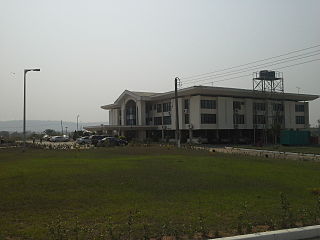
Rashtreeya Vidyalaya College of Engineering is an autonomous private technical co-educational college established in Bangalore, India in 1963. RVCE is recognized as a center of excellence under Technical Education Quality Improvement Program by Government of India.

Ashesi University is a private, non-profit university located in Berekuso, near Accra. The mission of Ashesi University is to educate ethical, entrepreneurial leaders in Africa; to cultivate within students the critical thinking skills, the concern for others, and the courage it will take to transform the continent.

Ghana Communication Technology University (GCTU) is a public technical university in Accra, Ghana founded in 2005.
The Pentecost University is a private university located at Sowutuom in the Greater Accra Region of Ghana. It was founded by The Church of Pentecost (COP) and evolved from The Pentecost Bible College which initially trained only Lay Leaders and full-time Ministers for the COP. On May 22, 2003, J. A. Kufuor, the former President of Ghana, inaugurated PUC at the Sowutuom campus. The first PUC Council was inducted on May 6, 2004. Pentvars was accredited by the National Accreditation Board (NAB), Ghana in November 2004 and awarded its Presidential Charter on May 28, 2020, by Nana Addo Dankwa Akufo-Addo, the President of the Republic of Ghana. Prior to receiving a Presidential Charter, the university was affiliated to the Kwame Nkrumah University of Science and Technology, University of Cape Coast, and University of Ghana. On June 1, 2020, the university announced the appointment of Rev. Prof. Kwabena Agyapong-Kodua, who replaces Apostle Daniel Okyere Walker, as the first Vice-Chancellor since the university became fully-fledged.
STUDSAT, is a CubeSat satellite designed by students. This project was conceptualised and project managed by undergraduate students across India. STUDSAT is a picosatellite successfully launched on 12 July 2010 from Satish Dhawan Space Centre into a Sun-synchronous orbit. The mission's objective was for students to have a hands-on experience with the design, fabrication and realisation of a space mission at a minimum cost. Experimental in nature, the mission life was stated to be six months.

The Technical University of Moldova is a higher technical educational institution located in Chișinău, Moldova, and is the only such institute in the country to be accredited by the state.

Koforidua Technical University is one of the ten Technical Universities established in every region in Ghana. It was founded in 1997. Since 1999 it has produced graduates with HND in accountancy,, marketing, purchasing and supply, statistics and computer science,currently offers degree programmes.

SRMSAT is a Nanosatellite built by students at Sri Ramaswamy Memorial University in India. The satellite is an Indian Technology demonstration and Earth observation satellite which is operated by the SRM Institute of Science and Technology. This nanosatellite was used to monitor Greenhouse gases in atmosphere.

GhanaSat-1 was the first Ghanaian nanosatellite to be launched into space. It was designed and built in two years in conjunction with the Kyushu Institute of Technology Birds-1 program, which has the goal of helping countries build their first satellite.

Mazaalai was a Mongolian nanosatellite CubeSat that was launched into space on 3 June 2017 as part of the SpaceX CRS-11 mission.

BRAC Onnesha was the first nanosatellite built in Bangladesh to be launched into space. The satellite was designed and built in conjunction with Kyushu Institute of Technology Birds-1 program, which has the goal of helping countries build their first satellite. It was designed and built over a two-year period.

Nigeria EduSat-1 was a Nigerian nanosatellite built by the Federal University of Technology Akure (FUTA), created in conjunction with the Japanese Birds-1 program. It was Nigeria's first satellite built by a university. It was launched from the Japanese Kibō module of the International Space Station.

Birds-1 was the first iteration of a multinational program called the Joint Global Multi-Nations Birds Satellite project, or Birds project, to help countries build their first satellite. The Japanese Kyushu Institute of Technology (KIT) supported the design and fabrication of the satellites. The constellation was launched by a Falcon 9 rocket to the International Space Station on 3 June 2017, as part of CRS-11, where it was released from the Kibō module into space. Japan, Ghana, Mongolia, Nigeria, and Bangladesh participated in the Birds-1 program, all building identical satellites for the constellation.

1KUNS-PF was the first Kenyan-owned satellite. The cubesat was developed and assembled by the University of Nairobi for the Kenya Space Agency, with technical support provided by Japan's Aerospace Exploration Agency. The spacecraft was deployed from the International Space Station are being launched by a SpaceX Falcon 9 rocket.

BHUTAN-1 was the first Bhutanese nanosatellite to be launched into space. The satellite was built during Kyushu Institute of Technology's Birds-2 program. The Birds program helps countries fly their first satellite. BHUTAN-1 was launched into orbit aboard the SpaceX CRS-15 mission on 29 June 2018. It was deployed from the Kibō module of the International Space Station (ISS) on 10 August 2018. The satellite had cameras to image the Earth.
Birds-2 is the second iteration of a multinational program called the Joint Global Multi-Nations Birds Satellite project, or Birds project, to help countries build their first satellite. The Japanese Kyushu Institute of Technology (KIT) supported the design and fabrication of the satellites. The satellites were launched by the Falcon 9 Full Thrust rocket as a part of the SpaceX CRS-15 mission on 29 June 2018. The satellites were released from the Kibō module of the International Space Station (ISS) in August 2018.
The domain of international space politics gained significant traction during the Cold War. This was largely fuelled by the ongoing space race between the USA and the USSR. At this time in history, space exploration was an endeavour largely restricted to the global superpowers and seemed out of reach for many smaller, developing, nations to actively participate in. Subsequently, public concerns for the cost of research and development into novel space technologies did not receive sufficient policy and academic attention in Africa. As the Cold War reached its conclusion, political power began to diffuse across the world, and this led to many smaller nation states developing national and regional space capabilities. In the context of Africa, Nigeria, Algeria, Egypt and South Africa were the front-runners in terms of investments into space-related research and development.



















